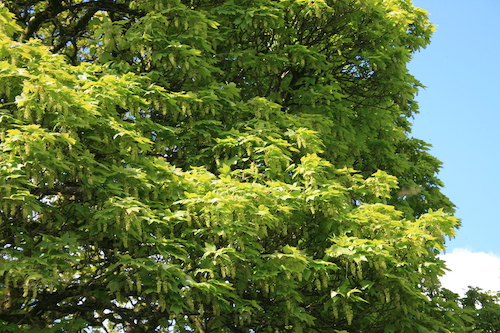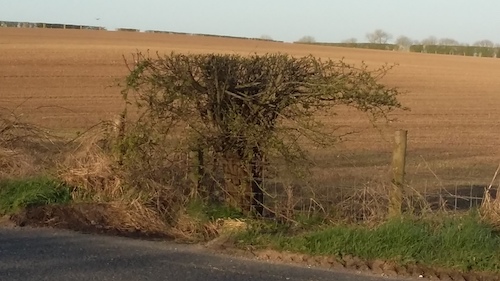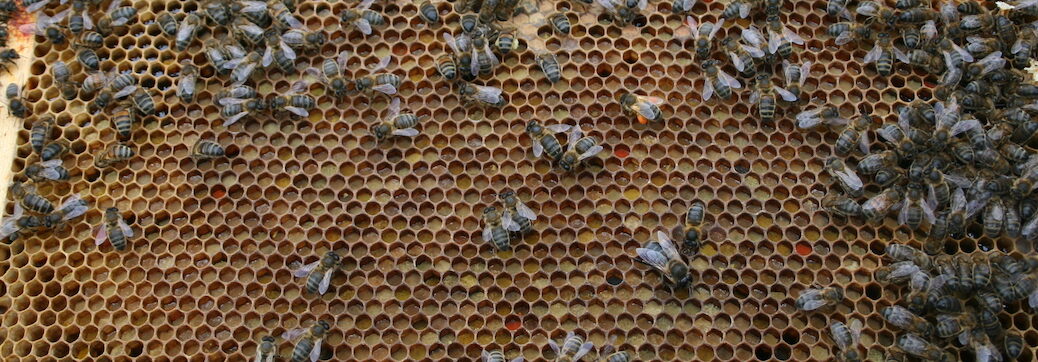A good supply of pollen is essential to a honeybee colony because…
… despite its complexity, bees cannot live on honey alone. While the sugars in honey supply their energy needs, in addition they require protein, minerals and trace elements. Pollen is the source of these but like all things dietary – bees need variety as well as quantity.
Importance of Pollen
The protein content of the pollen of different plants is variable but generally very high, containing amounts comparable with peas and beans (Witherell), or seeds and peanuts (Dietz).
Protein is important because it is the building material for growth and tissue repair. As a measure of the importance of the protein in pollen, it has been shown that the amount available to a colony influences the size of the emerging brood. In fact it has been calculated that the amount of pollen required to rear a bee – from the hatching of the egg to the emergence of the adult – is between 120 and 145mg.
But it doesn’t stop there because bees continue to grow after emergence. On average, emerging bees contain 13% protein (Witherell) but by the time they are 5 days old, the heads, thoraces and abdomens of young bees contain 93%, 38%,76%, more protein respectively than those of the newly emerged (Dietz). This huge increase is brought about by a massive consumption of pollen which is initiated within a very short time of emergence, perhaps as little as two hours, and rises to a peak at about 5-9 days old before gradually diminishing and eventually tailing off at 15-18 days (Dietz).
However not all this protein intake is used in growth of the bee or development of the hypopharyngeal glands because it is on about the 3rd day after emergence that the bees are directly employed in brood rearing, an activity that continues up until about the 13th day (Gary) and involves the passing on of pollen-derived protein to larvae in bee milk.
During brood rearing, a nurse bee needs to digest about 10mg of pollen to produce 4mg of protein per day in brood food which is produced in the hypopharyngeal glands. The more protein that is available to the nurse bees either by concentration in, or sheer bulk of, pollen the more larvae a bee is able to feed.
Principal constituents of pollen…
In addition to protein and lipids (fats) pollen contains:
- free amino acids;
- carbohydrates (sugars, starch and cellulose);
- minerals (calcium, magnesium, phosphorus, iron, sodium, potassium, aluminium, manganese, sulphur and copper);
- vitamins – pantothenic acid, nicotinic acid, thiamine, riboflavin, ascorbic acid and small amounts of vitamins D and E;
- enzymes and coenzymes;
- pigments xanthophyll and carotene;
- sterols (Witherell).
Because these ingredients are so variable between different pollens, it is thought that bees need a good mixture of pollens to be sure they are having a balanced diet.
Minerals and Trace Elements
Who knows what minerals and trace elements are now missing from the bees’ diets as a result of the decline in wild flowers and wild flower species.
We humans know the importance of a balanced diet with lots of variety to cover the full spectrum of our dietary requirements. Peculiar conditions like ricketts or scurvy can arise when small amounts of vital vitamins or nutrients are missing. Malnutrition also affects the immune system.
The likely effects of a shortage of pollen in late summer and autumn are…
…that the amount of pollen the bees manage to store will be insufficient to take them through to April and the start of the season proper. The significance of this is that the queen perks up and starts to lay, albeit at a slow rate, very early in the spring and long before fresh pollen becomes available in any sort of quantity. At this time nurse bees need to increase their pollen intake to kick-start their hypopharygeal glands so that they will be able to feed the emerging brood. If the required pollen is not there, it could mean that the colony will be unable to feed the larvae properly resulting in small bees and a possible late start into the season.
The bottom line of all this could be a reduction in colony strength especially if spring, and summer for that matter, are delayed, poor or cancelled altogether. A late start to the season could also mean them failing to make the most of the early flows such as dandelion. More generally it could leave the colony weakened and vulnerable to all of the assorted brutalities of nature.
This situation arose in the spring of 2013 which became very cold and continued forever. The effects of this were made worse because it followed the miserable autumn of 2012 where the bees failed to work the ivy to any significant extent. And of course the autumn of 2012 followed the most disastrous summer for beekeeping in history with record breaking queen failure because of the atrocious, striped weather. But don’t get me started.
It is advisable to keep a stock of pollen supplement or substitute for situations such as this. In that terrible spring it was impossible to buy supplement or substitute because of course everybody was in the same boat.
Some important sources of pollen…
… in this locality important sources of pollen include:- Gorse, Hazel, Willow, Dandelion, Oilseed rape, Hawthorn, Apple, Sycamore, Horse chestnut, Clover, Raspberry, Lime, Blackberry, Thistles, Ragwort, Knapweed, Native Ling and Bell heathers, Ivy.



Reseeding
In addition are the many native wild flowers too numerous to list which are commonly known as ‘weeds’. These used to be common and widespread in agricultural pastures but unfortunately these species-rich meadows are rapidly being ploughed up and replaced with single species grasslands. To pollinating insects, these ‘improved grasslands’ are wilderness areas. Clovers are being encouraged as a forage crop and soil improver but the cultivars popular with farmers tend to be large plants bred for rapid biomass accumulation and nitrogen fixing. The bees don’t seem to like them perhaps because the flowers are so big the bees tongues cannot reach the appropriate part but who knows when, or even if, these plants secrete nectar at all.
Scrub
The grubbing out of ‘scrub’, which includes important early spring pollen sources such as gorse, willow and hazel has further reduced availability locally meaning bees must fly further to forage leaving fewer bees to feed the brood. A shortage of nurse bees can lead to a chilled brood nest which can kill brood or lead to proliferation of brood diseases such as chalkbrood.
Hedgerows
Hedgerows of flowering trees such as hawthorn and blackthorn, blackberry, gorse and holly were once great pollen sources for pollinators. However, the relaxation of quotas and the mushrooming of intensive dairying has seen the removal from the landscape of thousands of miles of hedgerows. More have been decapitated and are ritually scalped year on year by tractors with flails so they can never flower.


Malnutrition and Disease
Anyone who has read Roger Patterson’s excellent article on Chalkbrood cannot but be suspicious of the possibility of malnutrition in the upsurge in chalkbrood. Here’s an exerpt:
“I will give details of one of my colonies (called “Rampion”) in 2013 that was a very cold wet spring, following a poor summer and winter. At inspections there was bad chalk brood and on 1st May I made a note to requeen the colony. It had built up very slowly. On 16th May the chalk brood was still bad with a covering on the floor, apart from one largely sealed comb that was very different from the rest. There wasn’t the “pepperpot” appearance of other combs and only a handful of infected cells. The obvious explanation is that this was a new comb, but it wasn’t, having been in the colony the previous year. I checked back and we had 3-4 days of good weather soon after that comb was laid up by the queen, so my thinking was the brood on that comb was fed better. An inspection on 7th June, after a spell of fine weather when the bees were doing very well, showed there was virtually no chalk brood in any of the combs. In this instance I think it showed the chalk brood was possibly caused by poor nutrition and was not genetic. In other respects the queen was good and I could have culled her when there was no need to. In the spring of 2013 chalk brood was bad in many colonies, so it would have been unreasonable to cull queens for that reason.”
Some serious research into the nutrition status of bees and other pollinators is needed urgently.
References and Bibliography
Dietz,A. Nutrition of the Adult Honey Bee. In The Hive and the Honey Bee. Ed. Dadant and Sons. Dadant Publications. Illinois. USA. 1979.
Gary,N.E. Activities and Behaviour or Honey Bees. In The Hive and the Honey Bee. Ed. Dadant and Sons. Dadant Publications. Illinois. USA. 1979.
Hooper,T. Guide to Bees and Honey. Blandford, London. 1991.
Witherell,P.C. Other Products of the Hive. In The Hive and the Honey Bee. Ed. Dadant and Sons. Dadant Publications. Illinois. USA. 1979.
Click here for a gallery of pollen loads
Click here for Roger Patterson’s Chalk Brood article
Copyright © Beespoke.info, 2022. All Rights Reserved.
